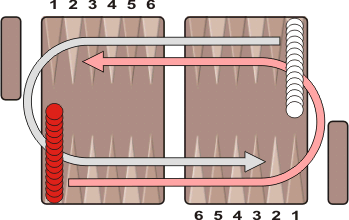![[Backgammon Galore!]](/gif/GaloreButton.gif)
|
|
Backgammon Variants Gul Bara is also called "Crazy Narde" or "Rosespring Backgammon." Setup: Each player starts with fifteen checkers on the rightmost point of the far side of the board, at diagonally opposite corners from each. They both move in the same direction, counterclockwise, around the board.
Object: The object of the game is to move all of your checkers around the board and bear them off. The first player to bear off all his checkers wins the game. To start: Both players roll one die and the higher number goes first. That player rolls the dice again to begin his turn. Movement: The roll of the dice indicates how many points, or pips, the player is to move his checkers. The following rules apply:
No hitting: A major difference between Gul Bara and other forms of backgammon is that there is no hitting in this game. One checker by itself controls a point, and an opposing checker may not land or touch down there. Doubles: During the first three rolls of the game, doubles are played as in backgammon: each number is played twice. For example, a roll of 6-6 means you have four sixes to use. When you roll doubles after the first three rolls, you not only play the number you rolled four times, but you also play each successive number four times. For example, if you roll 3-3, you play your four 3's, and then four 4's, and then four 5's, and then four 6's. If at any point you are unable to play all four numbers, you lose the remainder of your turn. In the early stages of a game, it is not difficult to play consecutive doubles. But since it only takes one checker to block a point, later in the game playing all your doubles is often quite difficult. Bearing Off: Once you have moved all fifteen of your checkers into your home board, you may begin bearing off. You bear off a checker by rolling a number that corresponds to the point on which it resides, then removing the checker from the board. If there is no checker on the point indicated by the roll, you must make a legal move using a checker on a higher-numbered point. If there are no checkers on higher-numbered points, you must remove a checker from the highest point that has a checker. Scoring: The first player to bear off all his checkers wins the game and gets one point. If the winner bears off all his checkers before the loser has borne off any, he gets two points. There is no doubling in this game.
References
|
![]()
Backgammon Galore : Variants

